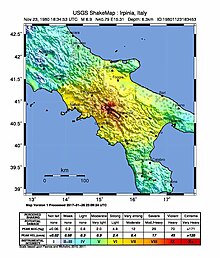
1980 Irpinia earthquake
You can help expand this article with text translated from the corresponding article in Italian. (January 2018) Click [show] for important translation instructions.
|
 Destruction in Campania after the earthquake | |
| UTC time | 1980-11-23 18:34:52 |
|---|---|
| ISC event | 635924 |
| USGS-ANSS | ComCat |
| Local date | 23 November 1980 |
| Local time | 19:34:52 CET[1] |
| Magnitude | 6.9 Mw[1] |
| Epicenter | 40°50′N 15°17′E / 40.84°N 15.28°E[1] |
| Type | Dip-slip[2] |
| Areas affected | Italy |
| Total damage | US$20 billion ($73.9 billion in 2024, adjusted for inflation)[3] |
| Max. intensity | MMI X (Extreme)[1] |
| Casualties | 2,483–4,900 dead[2] 7,700–8,934 injured[2] 250,000 displaced[2] |
The 1980 Irpinia earthquake (Italian: Terremoto dell'Irpinia) took place in Italy on 23 November 1980, with a moment magnitude of 6.9 and a maximum Mercalli intensity of X (Extreme). It left at least 2,483 people dead, at least 7,700 injured, and 250,000 homeless.

Earthquake

The earthquake struck at 18:34 UTC (19:34 local), centered on the village of Castelnuovo di Conza, Campania, Southern Italy.[4] The first jolt was followed by 90 aftershocks. There were three main shocks, each with epicenters in a different place, within 80 seconds. The largest shock registered a peak acceleration of 0.38 g, with 10 seconds of motion greater than 0.1 g. The three main shocks combined produced 70 seconds of shaking greater than 0.01 g. Thus the shaking was severe and lasted a long time.[5]

The focal mechanism corresponded to normal and significant left-lateral strike-slip movement. The rupture dimensions was estimated to be 14 km × 40 km (8.7 mi × 24.9 mi) based on the aftershock distribution.[6] The study of near-field strong motion and leveling records revealed a complex rupture process comprising three subevents. Overall, the rupture on complex fault systems propagated bilaterally along a mostly northwest–southeast trend.[7]

Impact
Towns in the province of Avellino were hit the hardest. In Sant'Angelo dei Lombardi, 300 were killed, including 27 children in an orphanage, and 80 percent of the town was destroyed and many historical buildings were left in ruins as the town never fully recovered as of 2021. One hundred were killed in Balvano when a medieval church collapsed during Sunday services. The towns of Lioni, Conza della Campania (near the epicenter), and Teora were destroyed, and dozens of structures in Naples were levelled, including a 10-story apartment building. Damage was spread over more than 26,000 km2 (10,000 sq mi), including Naples and Salerno.[5]

Rebuilding
The Italian government spent 59 trillion lire (equivalent to €151 billion in 2020) on reconstruction, while other nations sent contributions. West Germany contributed 32 million United States dollars (USD) and the United States US$70 million.[8]

However, in the early 1990s a major corruption scandal emerged. Of the billions of lire that were earmarked for aid to the victims and rebuilding, the largest part disappeared from the earthquake reconstruction funds in the 1980s. Of the $40 billion spent on earthquake reconstruction, an estimated $20 billion went to create an entirely new social class of millionaires in the region, $6.4 billion went to the criminal Camorra, whereas another $4 billion went to politicians in bribes. Only the remaining $9.6 billion, a quarter of the total amount, was actually spent on people's needs.[9]

The Camorra entered the construction industry after the quake.[10]

See also
- List of earthquakes in 1980
- List of earthquakes in Italy
- 1930 Irpinia earthquake
- List of earthquakes in Irpinia
Footnotes
- ^ a b c d Rovida, Andrea; Camassi, Romano; Gasperini, Paolo; Stucchi, Massimiliano (2011), "Earthquake catalog", in Rovida, A.; Camassi, R.; Gasperini, P.; Stucchi, M. (eds.), CPTI11, the 2011 version of the Parametric Catalogue of Italian Earthquakes (Data Set), Milano, Bologna: National Institute of Geophysics and Volcanology, doi:10.6092/INGV.IT-CPTI11
- ^ a b c d PAGER-CAT Earthquake Catalog, Version 2008_06.1, United States Geological Survey, September 4, 2009
- ^ National Geophysical Data Center / World Data Service (NGDC/WDS) (1972). "Significant Earthquake Database" (Data Set). National Geophysical Data Center, NOAA. doi:10.7289/V5TD9V7K.
- ^ Rovida, Andrea; Locati, Mario; Camassi, Romano; Lolli, Barbara; Gasperini, Paolo (23 July 2016). "1980 November 23 18:34:52.00 Irpinia-Basilicata". emidius.mi.ingv.it". doi:10.6092/INGV.IT-CPTI15.
- ^ a b Italy: Avellino, Potenza, Caserta, Naples. NOAA National Geophysical Data Center, Boulder (Colorado). Accessed 2009-04-07. Archived 2009-05-06.
- ^ Deschamps, A.; King, G.C.P. (1983). "The Campania-Lucania (southern Italy) earthquake of 23 November 1980". Earth and Planetary Science Letters. 62 (2): 296–304. Bibcode:1983E&PSL..62..296D. doi:10.1016/0012-821X(83)90092-4.
- ^ Bernard, Pascal; Zollo, Aldo (1989). "The Irpinia (Italy) 1980 earthquake: Detailed analysis of a complex normal faulting". Journal of Geophysical Research: Solid Earth. 94 (B2): 1631–1647. Bibcode:1989JGR....94.1631B. doi:10.1029/JB094iB02p01631.
- ^ Antonello Caporale (2004-12-13), Irpinia, 20 anni dopo (in Italian), la Repubblica, retrieved 2009-04-07
- ^ Behan, Tom (1996). The Camorra. Routledge. p. 188. ISBN 978-1138006737.
- ^ McKenna, Josephine (28 August 2016). "Italy must block mafia from earthquake rebuild, says prosecutor". The Guardian.
Further reading
- Gizzi, Fabrizio Terenzio; Potenza, Maria Rosaria (December 2020). "The Scientific Landscape of November 23rd, 1980 Irpinia-Basilicata Earthquake: Taking Stock of (Almost) 40 Years of Studies". Geosciences. 10 (12): 482. Bibcode:2020Geosc..10..482G. doi:10.3390/geosciences10120482.
- Porfido, Sabina; Alessio, Giuliana; Gaudiosi, Germana; Nappi, Rosa; Michetti, Alessandro Maria; Spiga, Efisio (2021). "Photographic Reportage on the Rebuilding after the Irpinia–Basilicata 1980 Earthquake (Southern Italy)". Geosciences. 11 (1): 6. doi:10.3390/geosciences11010006.
External links
- INGV – sismica Map (in Italian)
- Memory and Images Earthquake 1980 (in Italian)
- Earthquake 1980 Gesualdo Archived 2007-03-12 at the Wayback Machine (in Italian)
- INGV page on the earthquake (in Italian)
- Dank für die deutsche Hilfe (in German), Hamburger Abendblatt, 1980-12-04
- The International Seismological Centre has a bibliography and/or authoritative data for this event.
See what we do next...
OR
By submitting your email or phone number, you're giving mschf permission to send you email and/or recurring marketing texts. Data rates may apply. Text stop to cancel, help for help.
Success: You're subscribed now !

